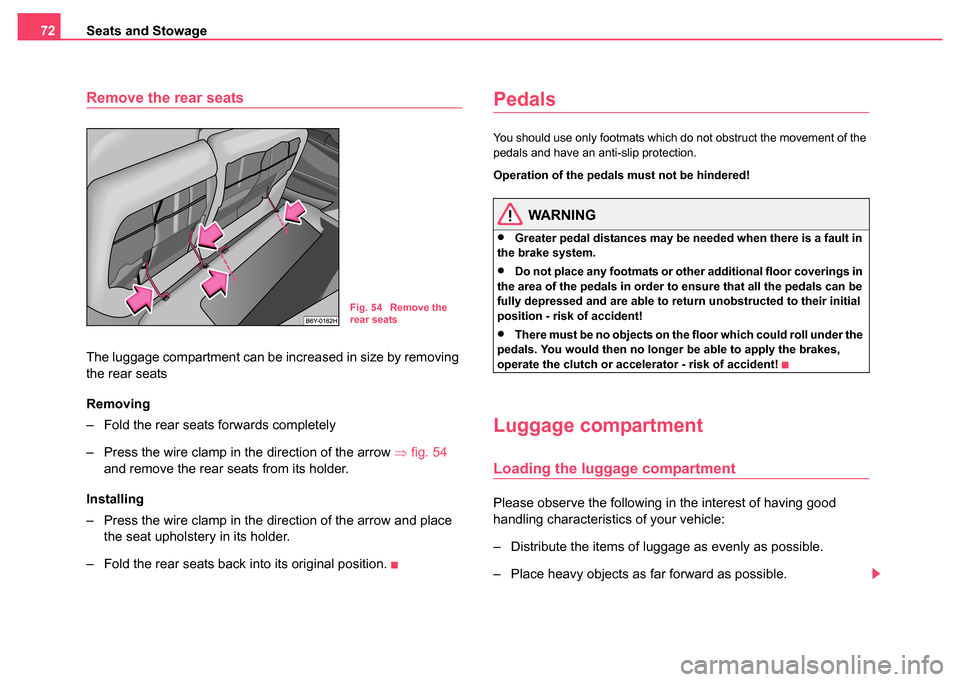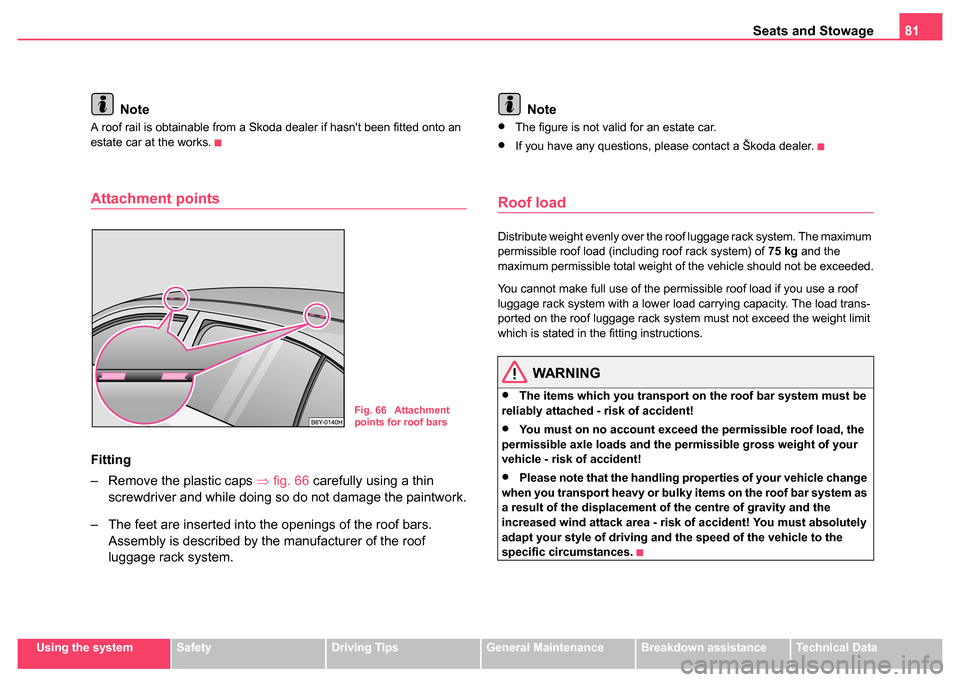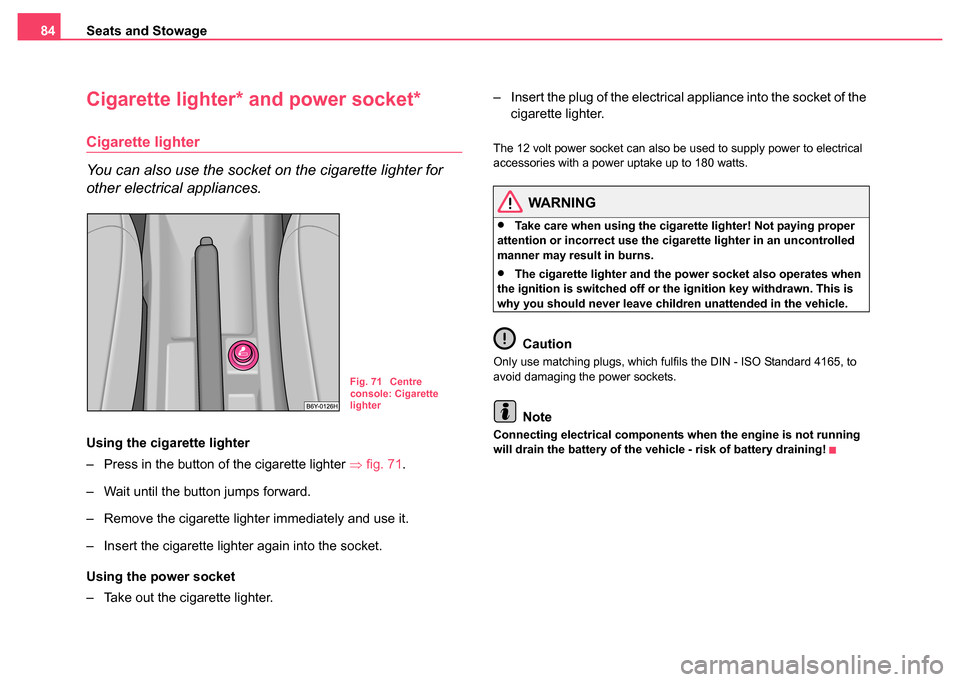remove seats SKODA FABIA 2004 1.G / 6Y Owner's Manual
[x] Cancel search | Manufacturer: SKODA, Model Year: 2004, Model line: FABIA, Model: SKODA FABIA 2004 1.G / 6YPages: 247
Page 70 of 247

Seats and Stowage69
Using the systemSafetyDriving TipsGeneral MaintenanceBreakdown assistanceTechnical Data
WARNING
•The head restraints must be correctly adjusted in order to offer
effective protection for the occupants in the event of an accident.
•Do not drive under any circumstance with removed head
restraints - risk of injury!
Middle rear head restraint*
The middle head restraints can be adjusted to two settings, the upper one
and the lower one. The upper setting is interlocked into place.
You must always press the securing button ⇒fig. 49 when removing the
head restraint and when pushing it out of the upper setting into the lower
setting.
WARNING
The head restraint on the middle rear seat must always be in the
upper locked position when someone is sitting there.
Heating the front seats*
The seating and leaning surfaces of the front seats can be heated
when the ignition is switched on.
Front seats
– Heating on the driver's ⇒fig. 50 and front pasenger's seat
can be switched on and regulated by turning the control dial
as required.
Fig. 49 Rear seats: the
position of the middle
head restraints
Fig. 50 Dash panel:
Control dial for heating
the front seats
Page 73 of 247

Seats and Stowage
72
Remove the rear seats
The luggage compartment can be increased in size by removing
the rear seats
Removing
– Fold the rear seats forwards completely
– Press the wire clamp in the direction of the arrow ⇒fig. 54
and remove the rear seats from its holder.
Installing
– Press the wire clamp in the direction of the arrow and place the seat upholstery in its holder.
– Fold the rear seats back into its original position.
Pedals
You should use only footmats which do not obstruct the movement of the
pedals and have an anti-slip protection.
Operation of the pedals must not be hindered!
WARNING
•Greater pedal distances may be needed when there is a fault in
the brake system.
•Do not place any footmats or other additional floor coverings in
the area of the pedals in order to ensure that all the pedals can be
fully depressed and are able to return unobstructed to their initial
position - risk of accident!
•There must be no objects on the floor which could roll under the
pedals. You would then no longer be able to apply the brakes,
operate the clutch or accelerator - risk of accident!
Luggage compartment
Loading the luggage compartment
Please observe the following in the interest of having good
handling characteristics of your vehicle:
– Distribute the items of luggage as evenly as possible.
– Place heavy objects as far forward as possible.
Fig. 54 Remove the
rear seats
Page 77 of 247

Seats and Stowage
76
The luggage compartment cover*
You can use the luggage compartment cover behind the
head restraints for storing light and soft items.
The luggage compartment cover can be removed as required if
one must transport bulky goods.
– Unhook the support straps on the tailgate.
– Place the cover on the side supports.
– Pull the cover to the rear out of the front holders ⇒fig. 59 .
– Install again by pushing it forwards into the holders and hanging the support straps on the tailgate.
WARNING
No objects should be placed on the luggage compartment cover,
the vehicle occupants could be endangered if there is sudden
braking or the vehicle collides with something.
Caution
Please ensure that the heating elements of the rear window heater are not
damaged as a result of objects placed in this area.
Note
When opening the boot lid, lift the luggage compartment cover - risk that
objects placed in this area can slip forward!
Luggage compartment cover (Estate car)
Fig. 59 Removing the
luggage compartment
cover
Fig. 60 Luggage
compartment: The
luggage compartment
cover
Page 78 of 247

Seats and Stowage77
Using the systemSafetyDriving TipsGeneral MaintenanceBreakdown assistanceTechnical Data
– Pull the luggage compartment cover in direction of arrow
⇒page 76, fig. 60.
– Hang the luggage compartment cover in the recesses on the side of the luggage compartment.
– Have the luggage compartment cover removed to transport bulky goods. Press the slider from the side in the direction of
arrow and remove the luggage compartment cover in the
direction of arrow .
WARNING
No objects should be placed on the luggage compartment cover,
the vehicle occupants could be endangered if there is sudden
braking or the vehicle collides with something.
Caution
Please ensure that the heating elements of the rear window heater and
luggage compartment cover are not damaged as a result of objects placed
in this area.
Net partition (Estate)*
Use behind the rear seats
A1
A2
Fig. 61 Unrolling net
partition
Fig. 62 Rolling up net
partition
Page 79 of 247

Seats and Stowage
78
Unrolling
– Fold down the rear seat backrests slightly forwards ⇒page 70, which makes it possible to clear the access for
unrolling the net partition.
– Pull the net partition at the bracket out of the housing in direction of the holders ⇒page 77, fig. 61.
– Insert the cross rod into one of the mounts and push the cross rod forward.
– In the same way, fix the cross rod to the other side of the vehicle, mount .
– Then push the seat backrest back into the upright position until it clicks into place - check by pulling on it ⇒.
Rolling up
– Pull the cross rod back slightly, first on the one side then on the other side and take the cross rod out of the mount
⇒page 77, fig. 62 .
– Hold the cross rod in such a way that the net partition can roll
up slowily and without damage into housing .
If you wish to use the entire luggage compartment, you can remove the
luggage compartment cover ⇒page 76, fig. 60 .
WARNING
•Ensure that the seat backrest on the rear seats is securely inter-
locked in position when the vehicle is fitted with three-point safety
belts for the middle rear seat. It is only then that the three-point seat
belt can reliably fulfil its function.
•First check for yourself that the cross road is inserted into the
mounts in the front position!
AAAB
AC
AC
AC
AC
AB
WARNING (continued)
AC
Page 82 of 247

Seats and Stowage81
Using the systemSafetyDriving TipsGeneral MaintenanceBreakdown assistanceTechnical Data
Note
A roof rail is obtainable from a Skoda dealer if hasn't been fitted onto an
estate car at the works.
Attachment points
Fitting
– Remove the plastic caps ⇒fig. 66 carefully using a thin
screwdriver and while doing so do not damage the paintwork.
– The feet are inserted into the openings of the roof bars. Assembly is described by the manufacturer of the roof
luggage rack system. Note
•The figure is not valid for an estate car.
•If you have any questions, please contact a Škoda dealer.
Roof load
Distribute weight evenly over the roof luggage rack system. The maximum
permissible roof load (including roof rack system) of
75 kg and the
maximum permissible total weight of the vehicle should not be exceeded.
You cannot make full use of the permissible roof load if you use a roof
luggage rack system with a lower load carrying capacity. The load trans-
ported on the roof luggage rack system must not exceed the weight limit
which is stated in the fitting instructions.
WARNING
•The items which you transport on the roof bar system must be
reliably attached - risk of accident!
•You must on no account exceed the permissible roof load, the
permissible axle loads and the permissible gross weight of your
vehicle - risk of accident!
•Please note that the handling properties of your vehicle change
when you transport heavy or bulky items on the roof bar system as
a result of the displacement of the centre of gravity and the
increased wind attack area - risk of accident! You must absolutely
adapt your style of driving and the speed of the vehicle to the
specific circumstances.
Fig. 66 Attachment
points for roof bars
Page 83 of 247

Seats and Stowage
82
Drinks can holder*
The drinks can holder is designed to place 0.33 litre drinks cans
in.
– Press on the symbol in the direction of
⇒ fig. 67 , the drinks
can holder slides out and opens up.
WARNING
The drinks can holder must always be closed when driving for
safety reasons.
Note holder
The note holder is designed for attaching a car park ticket in parking
areas.
The attached car park ticket must be removed before starting off in order
not to restrict the driver's vision.
Fig. 67 Dash panel:
Drinks can holderFig. 68 Windscreen:
Note holder
Page 85 of 247

Seats and Stowage
84
Cigarette lighter* and power socket*
Cigarette lighter
You can also use the socket on the cigarette lighter for
other electrical appliances.
Using the cigarette lighter
– Press in the button of the cigarette lighter ⇒fig. 71.
– Wait until the button jumps forward.
– Remove the cigarette lighter immediately and use it.
– Insert the cigarette lighter again into the socket.
Using the power socket
– Take out the cigarette lighter. – Insert the plug of the electrical appliance into the socket of the
cigarette lighter.
The 12 volt power socket can also be used to supply power to electrical
accessories with a power uptake up to 180 watts.
WARNING
•Take care when using the cigarette lighter! Not paying proper
attention or incorrect use the cigarette lighter in an uncontrolled
manner may result in burns.
•The cigarette lighter and the power socket also operates when
the ignition is switched off or the ignition key withdrawn. This is
why you should never leave children unattended in the vehicle.
Caution
Only use matching plugs, which fulfils the DIN - ISO Standard 4165, to
avoid damaging the power sockets.
Note
Connecting electrical components when the engine is not running
will drain the battery of the vehicle - risk of battery draining!
Fig. 71 Centre
console: Cigarette
lighter
Page 176 of 247

Care and cleaning175
Using the systemSafetyDriving TipsGeneral MaintenanceBreakdown assistanceTechnical Data
Caution
•Engine cleaning may be only be undertaken when the ignition is off.
•It is recommended to cover the generator before washing the engine
compartment.
For the sake of the environment
The dirty water produced by washing the engine has washed away petrol,
and residues of grease and oil and should therefore be cleaned by an oil
separator. This is why engine washing should only be undertaken in a
garage or at a fueling station (when these are fitted with the required
equipment).
Care of the interior of vehicle
Plastic parts, artificial leather and cloths
You can clean plastic parts and artificial leather with a moist cloth. You
should only treat such parts with special solvent-free plastic cleaning
and care products it does prove to be adequate.
Upholstery cloth and cloth trim on the doors, luggage compartment cover,
headliner etc. are best treated with special cleaning products, using if
necessary a dry foam and a soft sponge or brush.
We recommend using a cleaning product from Škoda genuine accesso-
ries offered by your Škoda dealer.
Caution
Solvent-free cleaners attack the material and can damage it.
Fabric covers of electrically heated seats
Do not clean the seat covers moist as this may result in damage to the
seat heating system.
Clean such covers using special agents, for example dry foam.
Natural leather
Natural leather requires quite particular care and attention.
Leather should be treated from time to time according the
following guidelines depending on how much it is used.
Normal cleaning
– Clean soiled areas of the leather with slightly moistened cotton or woollen cloth.
Severe soiling
– Clean severely soiled areas with a cloth dipped in a mild soapy solution (2 spoonfuls of natural soap to 1 litre of water).
– Ensure that the leather is not soaked through at any point and that no water gets into the stitching of the seams.
– Dry off the leather with a soft, dry cloth.
Removing stains
– Remove fresh stains which are water-based (e.g. coffee, tea,
juices, blood etc.) with an absorbent cloth or household paper
or use the cleaner from the care set for a stain which has
already dried in.